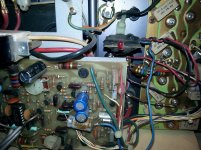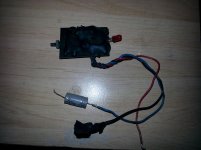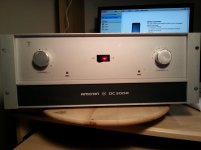Picked up a `76 vintage IOC equipped Crown the other day, I find the power measurements to be a little on the anemic side.
I`m getting 163@8, 1khz single channel driven and 512@8 1khz mono.
DC offsets are normal, line voltage at 118. Supply rails 60vDC.
Every other 300a I recall measuring would easily do 180+ all day long.
Hmmm.......
I`m getting 163@8, 1khz single channel driven and 512@8 1khz mono.
DC offsets are normal, line voltage at 118. Supply rails 60vDC.
Every other 300a I recall measuring would easily do 180+ all day long.
Hmmm.......
how did you measure it?
@1% THD or observed clipping on a scope
IMO seems within some meas. accuracy bounds perhaps excess ripple or unexpected drop on supply side. I couldn't hear the difference (180-163)/180 ~9%
At the onset of waveform clipping and IOC illumination. It`s worth mentioning that the negative cycle will clip around 3 volts before the positive. What would cause such asymmetry?
At the onset of waveform clipping and IOC illumination. It`s worth mentioning that the negative cycle will clip around 3 volts before the positive. What would cause such asymmetry?
PNP/ P channel side ?
PNP/ P channel side ?
NPN, quasi complementary.
Dunno… you're looking at a 1.1 volt peak drop from the 1970s measurements. You're also looking at a 0.47 dB max-amplitude headroom loss. I'd call that “perfectly reasonable”, as long as it is stabile. Most likely “something” has drifted internally. But “back in the day” the rail voltage was NOT regulated. Filtered, yes. Regulated, no. Could have been running the things off hotter mains back then.
Just saying. i don't think I share the disappointment.
GoatGuy
Just saying. i don't think I share the disappointment.
GoatGuy
Me neither.
We are talking almost unmeasurable, definitely impossible to hear with any certainty 0.47dB as stated above.
And not only wall voltage may change, **measuring instruments** too, how do you know the test instruments used 40 years ago were better than 5% accurate?
Were they digital or needle meters?
and so on.
We are talking almost unmeasurable, definitely impossible to hear with any certainty 0.47dB as stated above.
And not only wall voltage may change, **measuring instruments** too, how do you know the test instruments used 40 years ago were better than 5% accurate?
Were they digital or needle meters?
and so on.
I have a couple pieces of Crown gear I bought new, geez, 45 years ago? A DC150A and an IC150. Both came with individual response curves drawn out for both units, on what test gear I know not, plus an evaluation sheet with all the 0.l% and so on distortion figures. Pretty thorough, and at least Crown thought the test stuff was pretty good.
The plot thickens
As it turns out, this is not a bone stock DC300a but one modified by Solotech, a local sound company which performed this mod on their entire arsenal of 300a`s.
What they did was use the 100 volt primary tap rather than the 120 and a limiter circuit was installed in, I`m guessing here, the feedback loop.
I`m sure Crown didnt endorse such a mod but they ran those amps that way for many many years.
For some reason, this particular amp had the limiters installed but the primary was set to 120 rather than 100.
The limiter circuit is mounted immediately above the 5 way binding posts. There is a red LED and 3 wires coming from the epoxy encapsulated board, two wires going to the output terminals and one to 4uf/50vNP cap and onto R210 on the driver board.
It didnt seem anything was added so I just removed them and crossed my fingers
This is what I`m getting now:
176@8 on each channel single channel driven @ 1khz,
356@3 under same conditions
531@8 mono
600@6 mono
Thats more like it.
As it turns out, this is not a bone stock DC300a but one modified by Solotech, a local sound company which performed this mod on their entire arsenal of 300a`s.
What they did was use the 100 volt primary tap rather than the 120 and a limiter circuit was installed in, I`m guessing here, the feedback loop.
I`m sure Crown didnt endorse such a mod but they ran those amps that way for many many years.
For some reason, this particular amp had the limiters installed but the primary was set to 120 rather than 100.
The limiter circuit is mounted immediately above the 5 way binding posts. There is a red LED and 3 wires coming from the epoxy encapsulated board, two wires going to the output terminals and one to 4uf/50vNP cap and onto R210 on the driver board.
It didnt seem anything was added so I just removed them and crossed my fingers
This is what I`m getting now:
176@8 on each channel single channel driven @ 1khz,
356@3 under same conditions
531@8 mono
600@6 mono
Thats more like it.
Attachments
Well, then it can't be fairly compared to an original DC300, can it?
As of the mystery board, it's very probably a limiter.
Limiters in normal use limit power output *just* before clipping, for best possible use of available power.
In PA use, a "150W" rated amplifier will work much better and provide mode *usable* power if hard limited to, say, 130 or 140W and held there than left free to clip and mud the sound.
To avoid that the PA desk operator will have to work harder and use, say, 100W average power so he has "a little" headroom to keep stuff clean.
Distortion improves guitar and even some bass playing, but muddies and confuses Voice, Drums and Keyboards.
As of the mystery board, it's very probably a limiter.
Limiters in normal use limit power output *just* before clipping, for best possible use of available power.
In PA use, a "150W" rated amplifier will work much better and provide mode *usable* power if hard limited to, say, 130 or 140W and held there than left free to clip and mud the sound.
To avoid that the PA desk operator will have to work harder and use, say, 100W average power so he has "a little" headroom to keep stuff clean.
Distortion improves guitar and even some bass playing, but muddies and confuses Voice, Drums and Keyboards.
Anomalies in the outputs.....................
This is what I`m getting now:
176@8 on each channel single channel driven @ 1khz,
356@3 under same conditions
531@8 mono
600@6 mono............
176W into 8r0 is equivalent to 37.52Vac
356W into 3r0 32.68Vac
531W into 8r0 (bridged) is equivalent to 265.5W into 4r0 and is 32.59Vac
Why is there less voltage available into 4r0 than into 3r0?
Taking 8r0 loading as 0dBV, then 4r0 is showing -1.22dBV
and into 3r0 is showing -1.20dBV.
This seems to indicate that the amplifier is losing output when asked to deliver higher currents.
A good power delivery amplifier loses <1dBV when driving half the rated load impedance.
A very good power delivery amplifier loses ~0.5dBV when driving half the rated load impedance.
R.Cordell states it slightly differently.
He says something along the lines of:
An amplifier should be able to deliver 180% of power into half the rated load resistance.
That would be 316.8W into 4r0 cf 176W into the rated 8r0.
When bridged that would become 633W into 8r0. 531W indicates the amplifier is current crippled.
Last edited:
Anomalies in the outputs.
176W into 8r0 is equivalent to 37.52Vac
356W into 3r0 32.68Vac
531W into 8r0 (bridged) is equivalent to 265.5W into 4r0 and is 32.59Vac
Why is there less voltage available into 4r0 than into 3r0?
Taking 8r0 loading as 0dBV, then 4r0 is showing -1.22dBV
and into 3r0 is showing -1.20dBV.
This seems to indicate that the amplifier is losing output when asked to deliver higher currents.
A good power delivery amplifier loses <1dBV when driving half the rated load impedance.
A very good power delivery amplifier loses ~0.5dBV when driving half the rated load impedance.
R.Cordell states it slightly differently.
He says something along the lines of:
An amplifier should be able to deliver 180% of power into half the rated load resistance.
That would be 316.8W into 4r0 cf 176W into the rated 8r0.
When bridged that would become 633W into 8r0. 531W indicates the amplifier is current crippled.
Keep in mind this is not a dual mono design, single channel driven specs will always be higher than when both channels are engaged as is the case in mono operation.
It is a two channel amplifier.
The channel current delivery is not very good and not even good.
In my view and according to R.Cordell's guide figure, it is mediocre.
A really bad amplifier will drop >=1.5dBV when asked to drive half the rated load impedance/resistance.
The figures quoted show pretty poor current delivery into the lower loads of 3r0 and 4r0 (bridged into 8r0)
Your reminder that the amplifier is being asked to deliver two channels simultaneously when bridged (mono operation), would account for the apparently lower dBV, when driving 4r+4r compared to driving 3r.
I'll restate my observations
176W into 8r0 is equivalent to 37.52Vac
356W into 3r0 32.68Vac
531W into 8r0 (bridged) is equivalent to 265.5W+265.5W into 4r0+4r0 and is 32.59Vac
This last figure shows that the transformer and PSU does account for some of the dBV drop when driving the 4r0 load resistance.
A test into 4r0 from one channel would confirm the numbers.
The channel current delivery is not very good and not even good.
In my view and according to R.Cordell's guide figure, it is mediocre.
A really bad amplifier will drop >=1.5dBV when asked to drive half the rated load impedance/resistance.
The figures quoted show pretty poor current delivery into the lower loads of 3r0 and 4r0 (bridged into 8r0)
Your reminder that the amplifier is being asked to deliver two channels simultaneously when bridged (mono operation), would account for the apparently lower dBV, when driving 4r+4r compared to driving 3r.
I'll restate my observations
176W into 8r0 is equivalent to 37.52Vac
356W into 3r0 32.68Vac
531W into 8r0 (bridged) is equivalent to 265.5W+265.5W into 4r0+4r0 and is 32.59Vac
This last figure shows that the transformer and PSU does account for some of the dBV drop when driving the 4r0 load resistance.
A test into 4r0 from one channel would confirm the numbers.
Last edited:
- Status
- This old topic is closed. If you want to reopen this topic, contact a moderator using the "Report Post" button.
- Home
- Amplifiers
- Solid State
- "Disappointing" DC-300a power measurements


